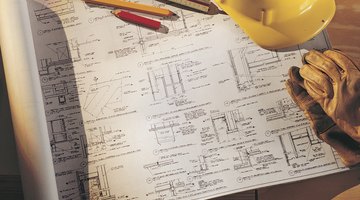How to Read Concrete Blueprints
Architects and engineers communicate with building trades in the form of construction plans and specifications. Reading blueprints is a skill that improves with each exposure to graphic language. Drawings are accompanied by written specifications.

Depending on the size of the project, the specifications may be separate documents or contained in the form of notes on the drawing. Note that where drawings conflict with written specifications, the specifications override the drawings. Reading construction plans in conjunction with the written specifications gives a clear understanding of the concrete portion of a structure and associated work.
Things You Will Need
- Drafting reference manual
- Construction drawings
- Written specifications
- Architects' scale (optional)
- Engineers' scale (optional)
- Highlighter
-
Review drafting manual for symbol identification, especially symbols for concrete, gravel, soil and reinforced steel bars and welded wire mesh. Become familiar with line conventions, including line weight, dashed and hidden lines and lines showing dimensions.
-
Examine the general conditions section of the written specifications first and note areas of responsibility and special concerns related to construction. Highlight points of potential conflict or confusion.
-
Find plans outlining concrete structures and related work, such as sitework and foundation plans. Organize plan, elevation and section and detail drawings for ease of cross-reference. Keep the written specifications close at hand.
-
Examine the plan views for horizontal information, such as layout and dimensions. Note reference and finish elevations, interior and exterior drainage details and locations where concrete work intersects with other trades. Study door and window openings for locations and dimensions. Look for notes about reinforcing steel.
-
Cross-reference plans with elevation, section and detail drawings for vertical information. Distinguish between typical details -- practices repeated throughout construction -- and specific details that occur only once.
-
Check written specifications for concrete mix design, subgrade material description, standard for quality of work and how to perform the work. Study any shop drawings for fabrication and connection details for special work.
-
Compare ground conditions with plans and note any discrepancies. List questions and observations and consult with the project manager for clarification.
Tip
Dimensions are written below and to the right of the drawing object. Reinforced steel information may be presented on the plans, in shop drawings or in specifications. Scales are useful for checking drawings but shouldn't be used to obtain dimensions from a drawing. Use dimensions written on the plans. Construction, isolation and contraction joints locations are usually located on the plan. Keep the most current drawing on hand during construction, with up-to-date revisions and change orders.
Warning
Don't be afraid to ask for clarification of issues on the plans. Construction plans and specifications can form the basis of court documents in matters of dispute, and misunderstanding can be costly.
The Drip Cap
- Architects and engineers communicate with building trades in the form of construction plans and specifications.
- Reading blueprints is a skill that improves with each exposure to graphic language.
- Reading construction plans in conjunction with the written specifications gives a clear understanding of the concrete portion of a structure and associated work.
- Become familiar with line conventions, including line weight, dashed and hidden lines and lines showing dimensions.
- Organize plan, elevation and section and detail drawings for ease of cross-reference.
References
- Construction Knowledge: Blueprint Reading
- Carpentry and Building Construction: John L. Feirer, et al.
Resources
Photo Credits
- Comstock/Comstock/Getty Images
- Comstock/Comstock/Getty Images
More Articles


